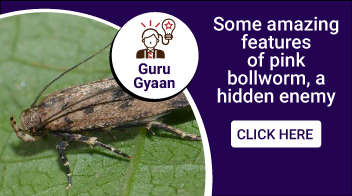
Guru GyaanAgroStar Agronomy Centre of Excellence
Some amazing features of pink bollworm, a hidden enemy
• The pink bollworm has been seen damaging any part of the country where there is cotton, not a single area of cotton has survived.
• Pink bollworm was first recorded 178 years ago i.e. in the year of 1842 and in time, it reached other cotton growing countries of the world.
• Pink bollworm do not damaging to any other crops except cotton in our country at present.
• In the absence of cotton, it survives on wild bhendi, jute, hollyhock, Abutilon (Indian mallow) like malvaceous plants; destroy such plants, if they are found around the field.
• Lava remains in dormant stage in cotton seeds, sometimes in this state for up to two and half years and invade when cotton is found.
• In winter i.e. during January-February, if occasional unseasonal rains occurs, there may an adverse effect on it dormancy.
• If there is no flowering and bud formation on cotton plants at emerging generation from the dormant stage, the pink bollworm dies and not survive, its known as suicidal generation; generally, towards the end of July and beginning of the August. That is why early sowing of cotton is not advised keeping this caterpillar in mind.
• This is the only caterpillar that initially clings to the petals of cotton flowers and makes them look like rosette flowers. Destroy such flowers as and when see.
• Larva prefers to live on 10 to 15 days old cotton bolls.
• A total of more than 70 natural enemies have reported, but not single giving satisfactory results.
• Along with the pheromone traps, PB-rope technique has also been successful, but is not currently available in the market easily.
• Bt cotton (BG II) was initially resistant, but over a time, it also became a victim of the larva. Now-a-days, pink bollworm is found in most of all the Bt cotton varieties.
• The adults of pink bollworm can live for one to two months by sucking the juice from the nectar glands present on the over surface of the leaves.
• The adults are very active in flying during late night till 3.00 am; hence keep the light trap on till the morning.
• Do you know how many eggs are laid by female moth? A female moth lays about 400 eggs in groups of 5-6.
• These eggs are laid in such places that even if you try to find out, it will not visible to you!!!!!
• Pupae take place in-between two cotton seeds in the cotton boll; is amazing!!!
• Once the caterpillar is entered into the boll, the hole is heal up naturally and cotton boll looks good from the outside, but if you cut, the larvae and damage can be seen.
• Sometimes the damaged boll becomes slightly awkward (deshaped).
• Even though it is known as pink bollworm, its early stage is white. Its later stage, it turns into a pink colour.
• Finally, for effective control of pink bollworm, spray chlorantraniliprole 9.3% + lambda cyhelothrin 4.6% ZC @ 5 ml or emamectin benzoate 5 SG @ 5 g per 10 lit of water.
Source: Agrostar Agronomy Centre of Excellence,
If you feel this information is useful to you, like and share it with your friends.
62
12

